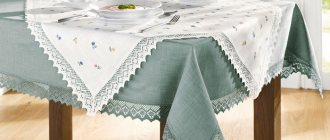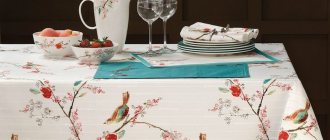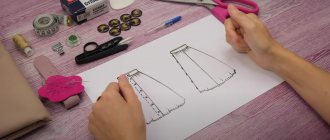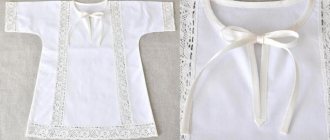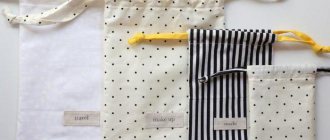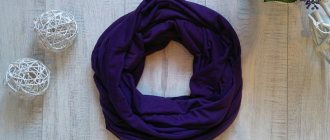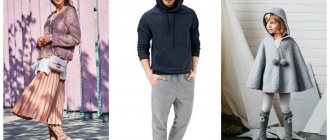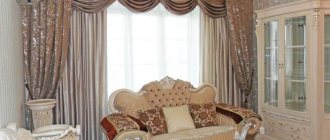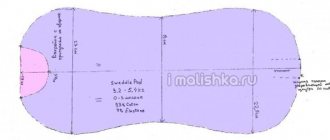Previously, tablecloths only decorated the festive table, but today they are an indispensable element of the interior, capable of correctly placing accents not only in the kitchen, but also in other rooms of the house. And if you make a tablecloth with your own hands, you will also receive an exclusive product, specially created according to your preferences.
In principle, the technology for creating holiday products and everyday ones is not significantly different; you just need to correctly approach the choice of material, shape, size calculation, as well as decorative framing.
Choosing fabric for a tablecloth
The tablecloth on the dining table should be pleasant, pleasing to the eye and setting you up to enjoy dining. In addition to the aesthetic side, do not forget that the dining table is the place where there will definitely be crumbs, drops of tea and stains from sauces, so the material from which the table covering is made should be quickly wiped off or washed and easily ironed.
A beautiful tablecloth - comfort in the house
When choosing fabric for a tablecloth, you should consider the following parameters:
- Purpose (dining, guest or holiday).
- Form.
- Room interior.
Interior in one style
- Quality of the material.
- Material cost.
For a dining table that will be used daily, linen and cotton in non-marking shades are suitable; these fabrics are traditional and elegant. Silk, satin, textured or smooth look perfect on the festive table; these fabrics are very elegant. It is very convenient to use modern fabrics for sewing:
- Mati, its composition includes 60% cotton and 40% polyester, which makes it wear-resistant and durable. In addition, mati is treated with an oil-repellent substance and greasy stains are removed from it easily and quickly.
Important! This fabric has a fire hazard class 1, it ignites quickly.
- The crane consists of cotton fibers with polyesters. It is treated with agents that repel grease and dirt.
Beauty from a crane
These fabrics are suitable for sewing tablecloths for restaurants and for the home.
Note! When choosing fabric for a tablecloth, you should not buy a smooth and slippery fabric; it will slide off the table and wrinkle under your hands.
There is also a huge selection of Teflon-impregnated textiles - soft, durable, easy to wash, these fabrics have a wide range of colors and textures.
Required materials and tools
To sew a product with your own hands, you will need a minimum set of materials and tools:
- First of all, this is, of course, fabric, thread and needle.
- Sewing machine for smooth and neat seams.
- Scissors (ideally for fabric).
- Tape measure.
- Ruler.
- Tailor's pins to avoid basting the fabric by hand.
- Pattern if the product will have a round or oval shape.
- Chalk or soap for applying patterns to fabric.
You might be interested in How to sew fabric puffs yourself
Only basic tools required
Here, perhaps, is the entire list of necessary tools for sewing a tablecloth at home.
How to measure a table depending on its shape
According to the rules of etiquette, the tablecloth should hang from the table to a certain length, which varies depending on the purpose of the covering:
- For the dining table - 20 cm.
- For a holiday - 30 cm.
- For official receptions and wedding banquets - 40 cm.
- For a buffet table - up to the floor.
To determine how much fabric you will need to sew a tablecloth, you need to measure the tabletop, add the length of the overhang and the hem allowance for the fabric (2.5-4 cm).
Important! To make the edge of the tablecloth heavier, you can leave a 10 cm allowance, 5 cm per hem, or trim the edge with a wide braid.
For a square table, calculating the size of the canvas is very simple. To do this, you only need to measure the length of one side of the table, add the length of the overhang and the allowance.
Square table top
For a rectangular table, you will need to measure two adjacent sides and add additional values. For example: the length of the table is 1.5 m and the width is 80 cm. For a tablecloth on the dining table you will need fabric measuring 1 m 98 cm in length and 1 m 28 cm in width.
To calculate the size of a product for a round table, you need to measure the diameter of the table, add the length of the overhang and allowances.
Note! The greatest difficulty will be in determining the size for an oval table.
In order to accurately repeat the oval of the table, you will have to make a pattern for the tablecloth. To do this, display the exact shape of the tabletop on paper, attach it to the panel and add the length of the overhang and allowance.
Oval table top
Possible decor
To make the tablecloth even more elegant, various frills or fringes are sewn at the bottom . You can place the lace in the middle of the hanging part or along the edge of the product. Using it only for room decoration, it is decorated with embroidery or appliqués in accordance with the interior. For dining tables, such decoration is not practical, as it complicates cleaning.
Wedding fabrics are often complemented with special skirts, which are decorated with draperies, flowers or ruffles.
An oval table is often covered with a rectangular tablecloth, but it does not look so impressive. Therefore, it is worth spending a little time making an oval tablecloth according to the shape of the tabletop.
Step-by-step sewing of a tablecloth for a round table
The cover on a round table looks very beautiful, covering the tabletop and hanging in loose waves, it will add romance and elegance to the room in which such a table is located.
Step 1. Calculation of fabric consumption
To calculate the fabric consumption for a round table, you need to measure the diameter of the tabletop and divide the resulting value by 2 to find out the radius. Add the length of the overhang and the length of the allowance to the radius and multiply the sum by 2. For example: (table diameter 2 m/2 + 30 cm overhang + 4 cm allowance) * 2 = size of the required fabric 2 m 68 cm by 2 m 68 cm.
You might be interested in the procedure for calculating and constructing the basis of a basic pattern
Step 2: Cut the fabric
The purchased piece of fabric needs to be cut. To do this, fold the canvas four times horizontally and vertically with the front side inward. To prevent the canvas from spreading, pin it together with pins and measure the following value: radius + overhang + allowance. You need to measure using a measuring tape and chalk. Apply one end of the centimeter to the inner corner, and the other to one of the sides of the resulting square at the required distance and move to the other side, making marks with chalk. Connect the marked marks to form an arc. Carefully cut off the excess along the line and process it with an overlocker so that the edges do not fray.
Cutting fabric
Step 3. Corner treatment
A round tablecloth, of course, has no corners, but if the tablecloth is square or rectangular, then the process of processing the corners must be approached very responsibly so that they turn out perfectly smooth and beautiful.
To process and hem corners you will need an iron and a ruler. First you need to mark the planned distance for the hem, this is done twice. Along the line, first fold and iron the first hem, then the second. You should smooth it carefully so that a clear trace of the line remains. By turning the corner you can see a square. You need to tuck the corner so that this square folds in half diagonally, and cut off the resulting small triangle. Next, you need to fold the first hem back and turn the corner inward, fold the second hem and press it. For reliability, you can secure it with a pin.
Corner processing
Step 4. Sew the hem
How to hem a round tablecloth. You need to measure and mark hem lines along the entire edge, fold and baste or secure with pins. For convenience, the hem can be ironed. Carefully stitch with minimal indentation or hem with an invisible seam by hand.
Step 5. Decoration
An ordinary tablecloth is sewn easily and simply, but if you want to add a touch of comfort, originality and extravagance, the tablecloth can be further decorated.
Do this using the following techniques:
- Playing with color or texture. The product can be made from two types of fabric, and they can be combined as a flight of fancy or the general interior of the room suggests.
- Frill. You can play with the length and volume of the overhang; if you add frills or drapery, you will get an elegant, lush tablecloth.
You might be interested in: Patterning and sewing a school skirt for a girl with your own hands
Playful tablecloth with ruffles
- Lace. You can use fine lace for edging on fancy tablecloths or thick lace for a country style linen tablecloth, there are many options. Since you can sew lace to a tablecloth in different ways, choose the most suitable one. The lace must either be sewn or crocheted onto the tablecloth with an overlap or below the overhang.
To decorate a tablecloth, you can use satin, beads, finishing ribbons, embroidery and other decorations; even a simple stitch made in a contrasting color can decorate the product.
Decorating tips
Decorating a tablecloth involves a variety of options. The choice of decor is completely individual, although it must still match the style and design of the kitchen space.
- Braid, satin ribbons, edging. These options are well suited for an everyday cotton tablecloth.
- Lace and flounces add airiness and softness to the lines.
- Embroidery is a win-win option for any fabric, but it gives linen models a special elegance.
- Appliques, sequins, beads, buttons - such decor should be combined with the design of other kitchen textiles (curtains, towels).
- Fringe. Suitable for decorating heavy, dense fabrics, such as jacquard.
Thematic appliqués (for example, New Year's) placed along the edge of the canvas will make the table more festive and elegant and will definitely appeal not only to children, but also to adults.
You can decorate and enliven a dull tablecloth with the help of additional accessories, for example, runners (serving paths), coasters for plates or napkins. There can be either several narrow runners (in this case they should hang down) or one large one across the entire table. Narrow runners serve as a substitute for plate stands and are placed one for each person present at the table.
Plate stands can be made from almost any material - fabric, cork, silicone, plastic. It is important here that they stand out against the background of the tablecloth, but at the same time fit into the overall composition and harmonize with it.
Regardless of which decoration method is chosen, the main thing is that it matches the style direction of the kitchen interior. If you manage to achieve a harmonious combination, the created atmosphere will delight not only the owners, but also dear guests for a long time.
Video
In the video there is a master class on sewing a tablecloth for a dining table.
August 10, 2014
Making your own napkins
When napkins sewn in the same style lie on the tablecloth, it looks beautiful and rich. You can also make napkins with your own hands from leftover fabric, or by planning the consumption in advance. Moreover, doing this is not difficult, like sewing a tablecloth.
First you need to decide what shape the napkins will be: square, rectangular or round, then outline the size, add seam allowances to it and cut it out. Then repeat the same steps as when sewing a tablecloth: iron the hem, work the corners, stitch the edges. The decor of the napkins can match the decor of the tablecloth, you can reduce it proportionally or come up with a different design.
Two-color product
We sew a tablecloth in 1 evening: a master class for beginners
There are several ways to sew tablecloths, because the corners and side cuts of the fabric can be processed in different ways. In this material we have described a traditional and basic method, having mastered which you will be able to sew with your own hands not only festive or everyday tablecloths, but also kitchen napkins, towels and runners with neat corners and edges.
Original options
Tablecloths made from two plain fabrics of the same color, but in different tones, look contrasting and unusual.
Path to pleasure
The coating, made in the form of a path, looks original.
Openwork sophistication
Openwork tablecloths, crocheted or sewn from pieces of lace, on a bare table or on a fabric base, are delicate and elegant for a romantic dinner or a pompous lunch.
DIY beauty
Sewing a tablecloth with your own hands is very easy. And you can get a lot of pleasure from the process, starting from the choice of fabrics and colors, the choice of which is very large and you can choose a fabric that will suit the interior of the room. The size of the tablecloth made by yourself will be exactly under the dining table and you will not have to tuck it or extend it with another tablecloth. And most importantly, with your own hands you can make a work of art, the likes of which no one else will have.
